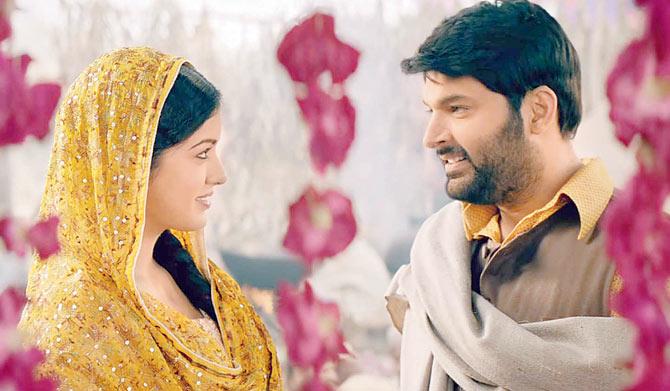It's really hard to suddenly take a comedian seriously. Unfair, but true

Besides stand-up comedian Kapil Sharma, the most popular Indian to emerge from Amritsar has to be Dr Manmohan Singh. This fact, I've noticed, Sharma tends to repeat a lot in his interviews. Surely there must be many other biggies from Amritsar. Top chef Vikas Khanna, for instance, comes to mind. But hearing his name, most Indians are likely to go, as voters always do after the elections: "Kaun sa vikaas! Kahan hai vikaas?" Khanna serves New Yorkers, mainly; he appears on Indian TV on occasion, so I guess he doesn't count.
ADVERTISEMENT

If Firangi is vaguely modeled on Lagaan, then Kapil Sharma is Aamir Khan
So let's stick to Sharma, and Dr Singh - both couldn't possibly belong to more separate worlds. The latter being the under-stated academic-bureaucrat, part-time politician, and a former Prime Minister, who's stood for the sort of civility in public life, that appears hard to replicate. Sharma, on the other hand, is a loud, arrogant kinda funnyman, who's suitably employed his quick-witted cockiness to introduce 'insult', or 'take-down' humour in mainstream Hindi stage-comedy. You may, or may not, agree with my assertion. Or, his comedy, for that matter. But you only have to compare Sharma with the past, relatively reverential, mainstream heroes of the Hindi stand-up scene, who were essentially "chutkula lekhaks" (joke tellers), even mimics, going, "Aur meri agli peshkash hai; mera agla item" - Johnny Lever, Raju Shrivas tav, and the lot - to sense how different Sharma was from the rest. This is besides the fact that he's infinitely better looking, which makes for better television.
Watching him first on Laughter Challenge, a talent hunt, where I suppose he made it big, I thought he was a Pakistani-Punjabi comedian. Maybe the suspicion had something to do with his style of comedy - it was semi-feudal, very sub-continental - where women/wives, house-helps, the audience, even the judges, were butts of jokes, a lot of which had to do with people's looks, or how poor they were, etc. To be fair, as the crow flies, Amritsar is less than 50 kilometres from Lahore. How much can man-made sarhad skew a sense of humour? And so, The Kapil Sharma Show, centred wholly on the lead stand-up comic - part-chat, part-skit, chiefly theatrical entertainment - seemed at once a cross between Umer Shareef's Pak plays (Buddha Ghar Par Hai, Baqra Qishton Pe, etc.), and the British-Asian The Kumars At 42, where Sanjeev Bhaskar plays a middle-aged son, Meera Sayal is the equivalent of daadi (cute grand-mum), and with a bunch of others, they interview celebrities visiting their make-believe living room, with the fourth wall facing the audience.
Kapil played Bittu Sharma on his show (which, by the way, is also the name of Sonam Kapoor's character in Delhi-6!). The incredibly crazy talent Sharma's show wonderfully showcased was actually the world's finest stand-up mimic, Sunil Grover - playing multiple characters, some of them in line with the show's strange obsession with cross-dressers. Don't know about you, I felt Grover was so much better than Sharma. But then, my reasons could be personal. Grover and I used to do shows on the same film channel over a decade ago, where he'd host what was called, 'Kaun Banega Champu' (brilliantly ad-libbing, imitating Amitabh Bachchan, Shah Rukh Khan). I was sincerely blown away by this wholly undiscovered star, secretly hoping he'd go a long way. He did.
But could you pull off The Kapil Sharma Show without Kapil Sharma? Of course, not. His instant connect with the masses was immeasurable. The part that endeared him most, I suspect, was the self-deprecating humour over his poor English, which automatically warmed him up to a whole lot of Indians whose English is no better, except they feel severely under-confident about it, given that one's fluency in the Queen's language is often perceived as a marker for class. Sharma made gags around it his unique selling proposition. For once, people laughed with him, rather than at him. The television ratings were to die for. Bollywood used this platform (as they would anything that has more than five people watching), to help sell their blockbuster pix. Viewership flew higher still. Sharma would share the stage (and grab greater footage) with the likes of SRK, Akshay Kumar, Salman Khan, and others. Sitting them down, he would ask if they'd ever imagined that some day, they would make it to The Kapil Sharma Show. This swag stood him apart. Most shows of a similar nature tend to look up to mainstream heroes. He looked straight at them, as an equal, without being terribly rude, of course.
The association was complete. People saw him as a traditional superstar. I'm sure he also saw himself as one. Directors Abbas-Mustan launched him in a typical Govinda-type comedy about three women lusting after this dude. I'm told the movie worked (hard to say). And then, I've just emerged from his latest film - a deliberately morose, pre-Independence period drama, where he underplays himself as a kind of a bumpkin, who saves a village from the British gora and the local king taking over. It's not meant to be comedy. If this is vaguely modeled on Lagaan, then he's Aamir Khan. We are suddenly meant to take him seriously. It's hard to. I feel sorry for him, even while yawning through it all. It's unfair. But then again, ambition's a bitch.
Mayank Shekhar attempts to make sense of mass culture. He tweets @mayankw14Send your feedback to mailbag@mid-day.com
 Subscribe today by clicking the link and stay updated with the latest news!" Click here!
Subscribe today by clicking the link and stay updated with the latest news!" Click here!









